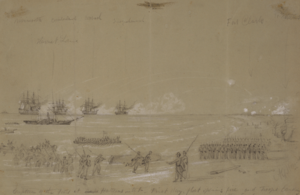Atlantic Blockading Squadron
| Atlantic Blockading Squadron | |
|---|---|

Capture of the Forts at Cape Hatteras Inlet by Alfred R. Waud, artist, August 28, 1861.
|
|
| Active | 1861 |
| Country |
|
| Branch |
|
| Type | naval squadron |
The Atlantic Blockading Squadron was a unit of the United States Navy created in the early days of the American Civil War to enforce a blockade of the ports of the Confederate States. It was formed in 1861 and split up the same year for the creation of the North Atlantic Blockading Squadron and the South Atlantic Blockading Squadron.
Following President Abraham Lincoln’s proclamation of a blockade of Southern ports on April 19, 1861 the Navy Department found it necessary to subdivide the territory assigned to the Home Squadron. This resulted in the creation of the Coast Blockading Squadron and the Gulf Blockading Squadron in early May 1861.
In orders sent on May 1, 1861 Secretary of the Navy Gideon Welles appointed Flag Officer Silas H. Stringham to command the Coast Blockading Squadron. Stringham received this order and took command on May 4, 1861. His new command was to be headquartered at Hampton Roads, Virginia and was given responsibility for the blockading of the coast from the capes of the Chesapeake to the southern extremity of Florida and Key West. On May 17, 1861 the Coast Blockading Squadron was re-designated the Atlantic Blockading Squadron.
On September 16, 1861 Stringham tendered his resignation as commander of the squadron following his receipt of a letter from Acting Secretary of the Navy Gustavus V. Fox that he felt indicated disapproval of his measures to enforce the blockade. Stringham’s resignation was accepted on September 18, 1861 and the same day Flag Officer Louis M. Goldsborough was appointed as his replacement. The transfer of command took place on September 23, 1861 when Goldsborough arrived at Hampton Roads. In communicating to Goldsborough about his appointment Gideon Welles stated that “more vigorous and energetic action must be taken” to enforce the blockade.
...
Wikipedia
